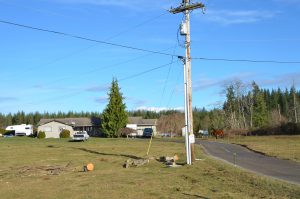 Electrical lines over roads can cause serious injury if a person, truck, or extension ladder come into contact with the charged line. Because of the risk of injury posed by overhead electrical lines, the National Electrical Safety Code (NESC) publishes strict guidelines for height clearance over roadways.
Electrical lines over roads can cause serious injury if a person, truck, or extension ladder come into contact with the charged line. Because of the risk of injury posed by overhead electrical lines, the National Electrical Safety Code (NESC) publishes strict guidelines for height clearance over roadways.
The NESC is published every five years by the Institute of Electrical and Electronics Engineers. The NESC creates rules and guidelines for electric supply stations, overhead lines, underground lines, and safety-related practices for utility workers. It is considered the industry standard for safety guidelines across the United States. The NESC may be adopted by state regulatory commissions. Although the NESC regulations are the industry standard, transportation departments, cities, and states may require additional clearances.
The required clearance under the NESC is dependent on the activity under or adjacent to the electrical lines and the type of cable or conductor. The minimum required height clearances for electrical lines over roadways subject to truck traffic are below:
- 5 feet for primary conductors;
- 16 feet for secondary wires;
- 5 feet for neutral wires 750V or less; and
- 5 feet for communication wires (cable TV, phone, fiber optic cables, etc.).
The clearances are the sum of three separate components. In order to calculate the required clearance, you must add together the reference component, mechanical component, and electrical component. The mechanical and electrical component are constant. The mechanical component is 2.0 feet and the electrical component is 2.5 feet. The reference component changes depending on the type of cable or conductor and activity below or adjacent to the electrical wire. Common reference components include: roadways, driveways, sidewalks, buildings, and billboards.
Clearances of electrical lines should be measured at the lowest point of sag. The sag refers to the vertical distance between the highest and lowest point of the wire’s curve. An overhead powerline that otherwise meets clearance standards in normal temperatures may no longer meet the required clearance in extreme temperatures or with additional load, such as ice. Therefore, the NESC requires that clearances be maintained at the worst case scenarios of 32°F with ice loading to 120°F.
If you see a low-hanging electrical line over a road, you should contact the utility company responsible for the line. The utility company can safely raise the height of the powerline to meet clearance requirements. You should assume all electrical lines are live and should never attempt to pass under an overhead electrical line that appears too low.
A utility company or third party could be liable if an electrical line running across a roadway causes injury or damage because it was hanging too low and did not meet clearance regulations. If you were in an accident involving an overhead powerline line, you should call the experienced personal injury attorneys at Kraft Davies Olsson. You may be entitled to certain damages or compensation. Please call our office at (206) 624-8844 or contact us through this website.
 Seattle Injury Lawyer Blog
Seattle Injury Lawyer Blog

